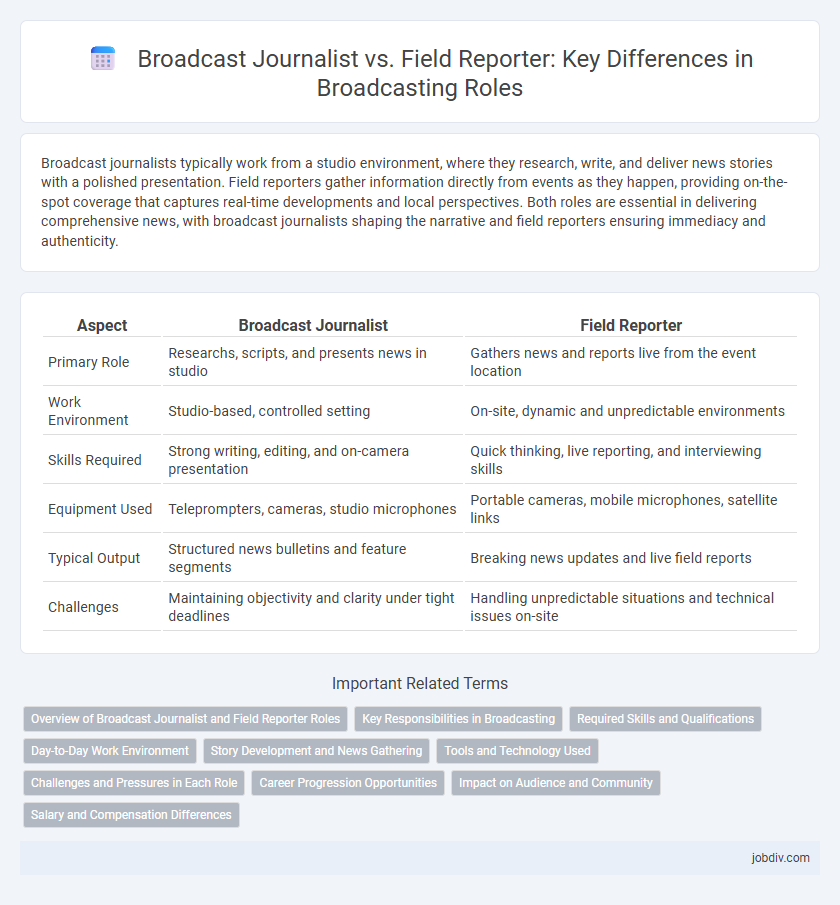Broadcast journalists typically work from a studio environment, where they research, write, and deliver news stories with a polished presentation. Field reporters gather information directly from events as they happen, providing on-the-spot coverage that captures real-time developments and local perspectives. Both roles are essential in delivering comprehensive news, with broadcast journalists shaping the narrative and field reporters ensuring immediacy and authenticity.
Table of Comparison
| Aspect | Broadcast Journalist | Field Reporter |
|---|---|---|
| Primary Role | Researchs, scripts, and presents news in studio | Gathers news and reports live from the event location |
| Work Environment | Studio-based, controlled setting | On-site, dynamic and unpredictable environments |
| Skills Required | Strong writing, editing, and on-camera presentation | Quick thinking, live reporting, and interviewing skills |
| Equipment Used | Teleprompters, cameras, studio microphones | Portable cameras, mobile microphones, satellite links |
| Typical Output | Structured news bulletins and feature segments | Breaking news updates and live field reports |
| Challenges | Maintaining objectivity and clarity under tight deadlines | Handling unpredictable situations and technical issues on-site |
Overview of Broadcast Journalist and Field Reporter Roles
Broadcast journalists research, write, and present news stories for television, radio, or digital platforms, often working from the newsroom to deliver polished, concise reports. Field reporters gather firsthand information on location, conducting interviews and capturing live footage or audio to provide real-time updates and in-depth coverage of events. Both roles require strong communication skills, journalistic integrity, and the ability to adapt to fast-paced news environments.
Key Responsibilities in Broadcasting
Broadcast journalists are responsible for researching, writing, and delivering news stories, often working in a studio setting to produce daily broadcasts and maintain editorial standards. Field reporters gather information directly from the location of events, conducting interviews and capturing live footage to provide timely, on-the-ground updates. Both roles require strong communication skills, with broadcast journalists focusing on content creation and presentation, while field reporters emphasize real-time news gathering and reporting.
Required Skills and Qualifications
Broadcast journalists require strong writing, editing, and on-air presentation skills, often holding degrees in journalism or communications. Field reporters need excellent communication, adaptability, and quick decision-making abilities, coupled with proficiency in handling live reporting equipment and working under varying environmental conditions. Both roles demand investigative skills, knowledge of media ethics, and the ability to meet tight deadlines.
Day-to-Day Work Environment
Broadcast journalists typically work in studio settings, conducting interviews, writing scripts, and producing news segments under tight deadlines. Field reporters operate on location, gathering firsthand information, capturing live footage, and delivering real-time updates amidst unpredictable environments. The day-to-day work for broadcast journalists tends to be more controlled and collaborative, whereas field reporters face dynamic, fast-paced conditions requiring adaptability and quick decision-making.
Story Development and News Gathering
Broadcast journalists develop comprehensive stories by researching, scripting, and overseeing the editorial process to deliver polished news segments. Field reporters specialize in on-the-ground news gathering, capturing real-time events, conducting interviews, and providing live updates directly from the location. Both roles are essential for accurate storytelling, with broadcast journalists shaping the narrative and field reporters supplying firsthand information.
Tools and Technology Used
Broadcast journalists typically rely on newsroom software, teleprompters, and studio cameras to deliver polished, live or recorded segments, while field reporters use portable video cameras, mobile editing apps, satellite phones, and wireless transmission tools to capture and send reports from diverse locations. Field reporters often depend on compact, rugged equipment like handheld microphones and drone cameras for real-time coverage, whereas broadcast journalists utilize advanced control room technology for script management and live broadcast switching. The evolving use of 5G networks and cloud-based platforms enhances both roles by enabling faster data transfer and seamless collaboration between field and studio teams.
Challenges and Pressures in Each Role
Broadcast journalists face intense deadlines and the pressure of delivering accurate, engaging news from the studio, often managing multiple stories simultaneously. Field reporters encounter unpredictable environments, technical difficulties, and the challenge of capturing live footage while ensuring personal safety in high-risk locations. Both roles demand resilience, adaptability, and strong communication skills to navigate the evolving dynamics of news broadcasting.
Career Progression Opportunities
Broadcast journalists often have a structured career progression, starting as reporters or researchers and advancing to anchors, producers, or editors within a newsroom. Field reporters specialize in on-location coverage, gaining expertise in live reporting and breaking news, which can lead to roles as senior correspondents or bureau chiefs. Both paths offer unique opportunities, with broadcast journalists moving towards studio-based positions and field reporters progressing in field leadership and specialized reporting roles.
Impact on Audience and Community
Broadcast journalists deliver comprehensive news stories from the studio, shaping public opinion through researched, well-rounded reports that provide context and analysis. Field reporters offer immediate, on-the-ground coverage, capturing raw, real-time events that engage audiences with authenticity and urgency. Together, their roles enhance community awareness by combining depth of information with direct eyewitness perspectives.
Salary and Compensation Differences
Broadcast journalists typically earn a higher average salary than field reporters due to their studio-based roles and additional responsibilities such as scripting and anchoring, with median annual salaries around $49,000 compared to $38,000 for field reporters. Field reporters often receive variable compensation influenced by travel, irregular hours, and on-site risks, which can include per diems and overtime pay, slightly balancing the base salary disparity. Salary differences also reflect experience levels, geographic location, and media market size, with metropolitan areas offering higher compensation for both positions.
Broadcast Journalist vs Field Reporter Infographic

 jobdiv.com
jobdiv.com